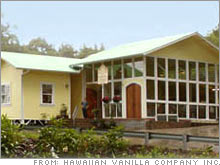25 acres, 5 kids, 300 pounds of vanillaJim and Tracy Reddekopp are growing a big family and a profitable vanilla business in Hawaii.(FSB) -- In 2000, Jim and Tracy Reddekopp and their four kids moved to a six-acre farm in Paauilo, Hawaii, off the Big Island's northeast Hamakua coast. On the property was a former coffee mill (turned slaughterhouse, turned vacant building) but the family planned to grow nothing more than ... more kids. But at Tracy's mother's suggestion that they grow vanilla, something just struck a chord in Jim, and he was off to the races. Seven later and with help from a Small Business Innovation Research (SBIR) grant from the USDA, the Reddekopps and their now five children produce 300 pounds of vanilla a year and average 200 visitors a week - about half from Norwegian Cruise Line ships - to the expanded 25-acre property.
A yellow and white wooden building, the Hawaiian Vanilla Company (hawaiianvanilla.com) has a gift shop open daily during the week and serves as home base for a tea brunch ($39), luncheon ($39), or vanilla tasting ($15). Each are served daily with advance reservations. Chef Tracy cooks the meals containing vanilla while Jim gives a lecture on the crop. I got in on the action at a four-course luncheon where we were served soup, salad, a roulade of local beef, and almond cake with vanilla ice cream. Whether or not it was detectable, every recipe included vanilla. Reddekopp, 43, has worked in tourism and marketing for 24 years, and it shows. His children are trained to reinforce the brand with a liberal sprinkling of the phrase "Hawaiian vanilla," as in "Would you like Hawaiian vanilla iced tea or Hawaiian vanilla lemonade?" (Best answer: both.) And while he does sell whole vanilla beans for $10 each, that's not his main focus. "I look at a bean and I see all the different ways I can use it," says Reddekopp. To stretch his profits - the business reached break-even in 2006 and is running a "small profit" - the Reddekopps have created a line of products containing their vanilla or its extract. In their gift shop, I find salad dressing ($15), tubs of vanilla sugar ($12), cards with illustrations of a vanilla orchid ($3.50), and vanilla coffee ($15 for eight ounces). The luncheon included a video and lecture about vanilla - it comes from an orchid on which each blossom blooms only one day a year and must be hand-pollinated - and we visit some orchids growing in the backyard. Unfortunately because of the need for sterile conditions, Jim can't take visitors through the greenhouse where his 12,000 orchid vines are growing. He's hoping to bring visitors closer to the growing action with a new greenhouse he plans to built on 14 acres recently purchased. In rural communities such as Paauilo, tourism can be difficult because neighbors often don't want the traffic tourists bring. And agritourism is a legal gray area - different aspects fall under agricultural or commercial zoning and there can be room for interpretation - so complaints can jeopardize a business. Reddekopp deals with the dilemma by involving his neighbors in the operation. The goat cheese served at luncheons comes from one neighbor, the salad greens from another. "If it's benefiting everybody, it'll work," says Reddekopp. "If it's not, it won't." |
Sponsors
|

